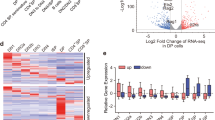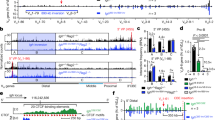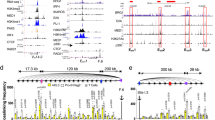Abstract
The assembly of genes encoding antigen receptors is regulated by developmental changes in chromatin that either permit or deny access to a single variable-(diversity)-joining recombinase. These changes are guided by transcriptional promoters and enhancers, which serve as accessibility-control elements in antigen-receptor loci. The function of each accessibility-control element and the factors they recruit to remodel chromatin remain obscure. Here we show that the recruitment of SWI-SNF chromatin-remodeling complexes compensated for the accessibility-control element function of a promoter but not an enhancer of the T cell receptor-β locus (Tcrb). Loss of SWI-SNF function in thymocytes inactivated recombinase targets at the endogenous Tcrb locus. Thus, initiation of Tcrb gene assembly and T cell development is contingent on the recruitment of SWI-SNF to promoters, which exposes gene segments to variable-(diversity)-joining recombinase.
This is a preview of subscription content, access via your institution
Access options
Subscribe to this journal
Receive 12 print issues and online access
$209.00 per year
only $17.42 per issue
Buy this article
- Purchase on Springer Link
- Instant access to full article PDF
Prices may be subject to local taxes which are calculated during checkout






Similar content being viewed by others
References
Cobb, R.M., Oestreich, K.J., Osipovich, O.A. & Oltz, E.M. Accessibility control of V(D)J recombination. Adv. Immunol. 91, 45–109 (2006).
Khorasanizadeh, S. The nucleosome: from genomic organization to genomic regulation. Cell 116, 259–272 (2004).
Jenuwein, T. & Allis, C.D. Translating the histone code. Science 293, 1074–1080 (2001).
Luger, K. Dynamic nucleosomes. Chromosome Res. 14, 5–16 (2006).
Woodcock, C.L. Chromatin architecture. Curr. Opin. Struct. Biol. 16, 213–220 (2006).
Cosma, M.P. Ordered recruitment: gene-specific mechanism of transcription activation. Mol. Cell 10, 227–236 (2002).
Forsberg, E.C. & Bresnick, E.H. Histone acetylation beyond promoters: long-range acetylation patterns in the chromatin world. Bioessays 23, 820–830 (2001).
Hatzis, P. & Talianidis, I. Dynamics of enhancer-promoter communication during differentiation-induced gene activation. Mol. Cell 10, 1467–1477 (2002).
Spicuglia, S. et al. Promoter activation by enhancer-dependent and -independent loading of activator and coactivator complexes. Mol. Cell 10, 1479–1487 (2002).
Workman, J.L. & Kingston, R.E. Alteration of nucleosome structure as a mechanism of transcriptional regulation. Annu. Rev. Biochem. 67, 545–579 (1998).
Laurent, B.C., Treich, I. & Carlson, M. The yeast SNF2/SWI2 protein has DNA-stimulated ATPase activity required for transcriptional activation. Genes Dev. 7, 583–591 (1993).
Narlikar, G.J., Fan, H.Y. & Kingston, R.E. Cooperation between complexes that regulate chromatin structure and transcription. Cell 108, 475–487 (2002).
Kassabov, S.R., Zhang, B., Persinger, J. & Bartholomew, B. SWI/SNF unwraps, slides, and rewraps the nucleosome. Mol. Cell 11, 391–403 (2003).
Kingston, R.E. & Narlikar, G.J. ATP-dependent remodeling and acetylation as regulators of chromatin fluidity. Genes Dev. 13, 2339–2352 (1999).
Bassing, C.H., Swat, W. & Alt, F.W. The mechanism and regulation of chromosomal V(D)J recombination. Cell 109 Suppl. S45–S55 (2002).
Krangel, M.S. Gene segment selection in V(D)J recombination: accessibility and beyond. Nat. Immunol. 4, 624–630 (2003).
Stanhope-Baker, P., Hudson, K.M., Shaffer, A.L., Constantinescu, A. & Schlissel, M.S. Cell type-specific chromatin structure determines the targeting of V(D)J recombinase activity in vitro. Cell 85, 887–897 (1996).
Oettinger, M.A., Schatz, D.G., Gorka, C. & Baltimore, D. RAG-1 and RAG-2, adjacent genes that synergistically activate V(D)J recombination. Science 248, 1517–1523 (1990).
Schatz, D.G., Oettinger, M.A. & Baltimore, D. The V(D)J recombination activating gene, RAG-1. Cell 59, 1035–1048 (1989).
Chowdhury, D. & Sen, R. Transient IL-7/IL-7R signaling provides a mechanism for feedback inhibition of immunoglobulin heavy chain gene rearrangements. Immunity 18, 229–241 (2003).
McMurry, M.T. & Krangel, M.S. A role for histone acetylation in the developmental regulation of VDJ recombination. Science 287, 495–498 (2000).
Morshead, K.B., Ciccone, D.N., Taverna, S.D., Allis, C.D. & Oettinger, M.A. Antigen receptor loci poised for V(D)J rearrangement are broadly associated with BRG1 and flanked by peaks of histone H3 dimethylated at lysine 4. Proc. Natl. Acad. Sci. USA 100, 11577–11582 (2003).
Oestreich, K.J. et al. Regulation of Tcrb gene assembly by a promoter/enhancer holocomplex. Immunity 24, 381–391 (2006).
Kwon, J., Morshead, K.B., Guyon, J.R., Kingston, R.E. & Oettinger, M.A. Histone acetylation and hSWI/SNF remodeling act in concert to stimulate V(D)J cleavage of nucleosomal DNA. Mol. Cell 6, 1037–1048 (2000).
Whitehurst, C.E., Schlissel, M.S. & Chen, J. Deletion of germline promoter PDβ1 from the Tcrb locus causes hypermethylation that impairs Dβ1 recombination by multiple mechanisms. Immunity 13, 703–714 (2000).
Sikes, M.L., Meade, A., Tripathi, R., Krangel, M.S. & Oltz, E.M. Regulation of V(D)J recombination: A dominant role for promoter positioning in gene segment accessibility. Proc. Natl. Acad. Sci. USA 99, 12309–12314 (2002).
Johnson, K., Angelin-Duclos, C., Park, S. & Calame, K.L. Changes in histone acetylation are associated with differences in accessibility of V(H) gene segments to V-DJ recombination during B-cell ontogeny and development. Mol. Cell. Biol. 23, 2438–2450 (2003).
Shinkai, Y. et al. RAG-2-deficient mice lack mature lymphocytes owing to inability to initiate V(D)J rearrangement. Cell 68, 855–867 (1992).
Bories, J.C., Demengeot, J., Davidson, L. & Alt, F.W. Gene-targeted deletion and replacement mutations of the T-cell receptor β-chain enhancer: the role of enhancer elements in controlling V(D)J recombination accessibility. Proc. Natl. Acad. Sci. USA 93, 7871–7876 (1996).
Mathieu, N., Hempel, W.M., Spicuglia, S., Verthuy, C. & Ferrier, P. Chromatin remodeling by the T cell receptor (TCR)-β gene enhancer during early T cell development: Implications for the control of TCR-β locus recombination. J. Exp. Med. 192, 625–636 (2000).
Ferrier, P. et al. Separate elements control DJ and VDJ rearrangement in a transgenic recombination substrate. EMBO J. 9, 117–125 (1990).
Sikes, M.L. & Oltz, E.M. An inducible cell model for studies of V(D)J recombinational control. J. Immunol. Methods 224, 25–29 (1999).
Oltz, E.M. et al. A V(D)J recombinase-inducible B-cell line: role of transcriptional enhancer elements in directing V(D)J recombination. Mol. Cell. Biol. 13, 6223–6230 (1993).
Osipovich, O. et al. Targeted inhibition of V(D)J recombination by a histone methyltransferase. Nat. Immunol. 5, 309–316 (2004).
de la Serna, I.L., Roy, K., Carlson, K.A. & Imbalzano, A.N. MyoD can induce cell cycle arrest but not muscle differentiation in the presence of dominant negative SWI/SNF chromatin remodeling enzymes. J. Biol. Chem. 276, 41486–41491 (2001).
Sikes, M.L., Suarez, C.C. & Oltz, E.M. Regulation of V(D)J recombination by transcriptional promoters. Mol. Cell. Biol. 19, 2773–2781 (1999).
Sikes, M.L., Gomez, R.J., Song, J. & Oltz, E.M. A developmental stage-specific promoter directs germline transcription of DßJβ gene segments in precursor T lymphocytes. J. Immunol. 161, 1399–1405 (1998).
Mombaerts, P., Terhorst, C., Jacks, T., Tonegawa, S. & Sancho, J. Characterization of immature thymocyte lines derived from T-cell receptor or recombination activating gene 1 and p53 double mutant mice. Proc. Natl. Acad. Sci. USA 92, 7420–7424 (1995).
Chi, T.H. et al. Sequential roles of Brg, the ATPase subunit of BAF chromatin remodeling complexes, in thymocyte development. Immunity 19, 169–182 (2003).
Chi, T.H. et al. Reciprocal regulation of CD4/CD8 expression by SWI/SNF-like BAF complexes. Nature 418, 195–199 (2002).
Ramirez-Carrozzi, V.R. et al. Selective and antagonistic functions of SWI/SNF and Mi-2beta nucleosome remodeling complexes during an inflammatory response. Genes Dev. 20, 282–296 (2006).
Shinkai, Y. et al. Restoration of T cell development in RAG-2-deficient mice by functional TCR transgenes. Science 259, 822–825 (1993).
Hesse, J.E., Lieber, M.R., Gellert, M. & Mizuuchi, K. Extrachromosomal DNA substrates in pre-B cells undergo inversion or deletion at immunoglobulin V-(D)-J joining signals. Cell 49, 775–783 (1987).
Chandy, M., Gutierrez, J.L., Prochasson, P. & Workman, J.L. SWI/SNF displaces SAGA-acetylated nucleosomes. Eukaryot. Cell 5, 1738–1747 (2006).
Hassan, A.H., Neely, K.E. & Workman, J.L. Histone acetyltransferase complexes stabilize Swi/Snf binding to promoter nucleosomes. Cell 104, 817–827 (2001).
Smale, S.T. & Fisher, A.G. Chromatin structure and gene regulation in the immune system. Annu. Rev. Immunol. 20, 427–462 (2002).
Baumann, M., Mamais, A., McBlane, F., Xiao, H. & Boyes, J. Regulation of V(D)J recombination by nucleosome positioning at recombination signal sequences. EMBO J. 22, 5197–5207 (2003).
Ooi, L., Belyaev, N.D., Miyake, K., Wood, I.C. & Buckley, N.J. BRG1 chromatin remodeling activity is required for efficient chromatin binding by repressor element 1-silencing transcription factor (REST) and facilitates REST-mediated repression. J. Biol. Chem. 281, 38974–38980 (2006).
Phelan, M.L., Schnitzler, G.R. & Kingston, R.E. Octamer transfer and creation of stably remodeled nucleosomes by human SWI-SNF and its isolated ATPases. Mol. Cell. Biol. 20, 6380–6389 (2000).
Zhang, F. & Boothby, M. T helper type 1-specific Brg1 recruitment and remodeling of nucleosomes positioned at the IFN-γ promoter are Stat4 dependent. J. Exp. Med. 203, 1493–1505 (2006).
Weinmann, A.S. et al. Nucleosome remodeling at the IL-12 p40 promoter is a TLR-dependent, Rel-independent event. Nat. Immunol. 2, 51–57 (2001).
Acknowledgements
We thank S. Smale (University of California at Los Angeles), J. Chen (Massachusetts Institute of Technology), M. Boothby (Vanderbilt University) and R. Kingston (Harvard University) for reagents, and F. Zhang for technical advice. Supported by the National Institutes of Health (P01 HL68744 and CA100905 to E.M.O.) and a Cancer Center Support Grant (P30 CA68485, Vanderbilt-Ingram Cancer Center).
Author information
Authors and Affiliations
Corresponding author
Ethics declarations
Competing interests
The authors declare no competing financial interests.
Supplementary information
Supplementary Text and Figures
Supplementary Figure 1 and Supplementary Table 1 (PDF 365 kb)
Rights and permissions
About this article
Cite this article
Osipovich, O., Milley Cobb, R., Oestreich, K. et al. Essential function for SWI-SNF chromatin-remodeling complexes in the promoter-directed assembly of Tcrb genes. Nat Immunol 8, 809–816 (2007). https://doi.org/10.1038/ni1481
Received:
Accepted:
Published:
Issue Date:
DOI: https://doi.org/10.1038/ni1481
This article is cited by
-
Histone reader BRWD1 targets and restricts recombination to the Igk locus
Nature Immunology (2015)
-
Transcription-coupled eviction of histones H2A/H2B governs V(D)J recombination
The EMBO Journal (2013)
-
Control of Ig gene assembly: lessons from premature activation
The EMBO Journal (2013)
-
Recombination centres and the orchestration of V(D)J recombination
Nature Reviews Immunology (2011)
-
Orchestrating T-cell receptor α gene assembly through changes in chromatin structure and organization
Immunologic Research (2011)



